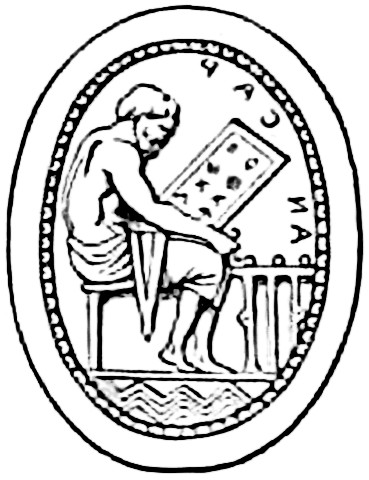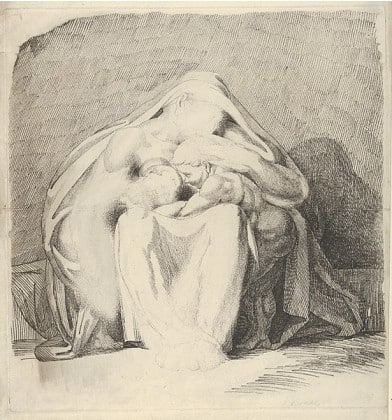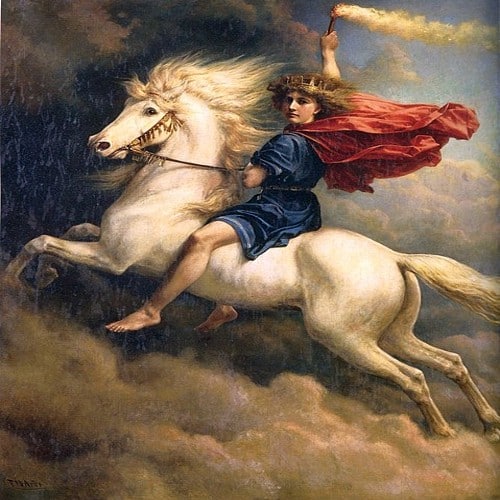Norse mythology is filled with gods and creatures of great power and significance. Among these, there are three gods and a jötun giantess, who are the personifications of night and day, sun and moon. Dagr stands out as the embodiment of day and daylight, casting his radiant glow upon the world. In this article I am exploring this seldom mentioned Norse god and where he actually came from.
Dagr Key Facts
| Parents | Nótt (jötun) and Dellingr (Aesir) |
| Partners | None known |
| Siblings | Auðr and Jǫrð |
| Offspring | None known |
| Tribe | Aesir |
| Old Norse name | Dagr |
| Other names | Day |
| The God of | The Day, Daylight |
| Ass. Animal | Skinfaxi (Shining-Mane) and Gladr (Bright, or Glad) |
Name and Etymology
Dagr, in Old Norse, translates to “day”, and is pretty close to my modern Norwegain dag. It stands as a testament to the daylight that bathes the world in its glow. This name isn’t merely a label but embodies the very essence of day. As such, this name made it to our list of best Viking names for boys and as Dagny, even onto the list of Viking Age names for girls.
Giving Dagrs’ name even more depth is the Elder Futhark rune “dagaz.” Beyond its phonetic representation of the “D” sound, this rune is intrinsically tied to the concept of day, serving as a direct symbol for Dagr. The clarity of this association is highlighted in runic inscriptions, such as the one found in Ingelstad (Ög 43), where the Dagaz rune is explicitly translated using the Old Norse term for “day” and is attributed as the personal name Dagr.
Ancient Roots
As I dive deeper into the linguistic lineage of Dagr, my understanding is that its roots is in the Proto-Germanic word ‘dagaz’, which translates to ‘day’. This connection between the Old Norse Dagr and the Proto-Germanic ‘dagaz’ offers a fascinating glimpse into the evolution of language and the reverence for this deity across various cultures. The name “Dagr” and its variations might also trace back to older Germanic or even Gothic mythologies, underscoring the age-old human desire to personify and understand the natural phenomena that shape their lives.
Dagr’s Origins
Exploring the origins of Dagr, Norse mythology presents us with a bit of a puzzle when it comes to his parentage. I feel I have to add that this is not especially uncommon and happens quite often as I am exploring old texts. Both the Poetic Edda and the Prose Edda, the two main sources for Norse myths, agree that Dagr is the son of the god Dellingr. However, when identifying his mother, things get a touch more complex.

The majority of accounts, especially those found in the Prose Edda, identify Nótt, the jötun personification of night, as Dagr’s mother. This pairing of night and dawn paints a poetic picture of the cyclical nature of time. Yet, some variations in the manuscripts suggest another potential mother: Jörð, the personified Earth. While these slight discrepancies exist, the consensus leans more towards Nótt as Dagr’s mother.
As for Dagr’s personal relationships, the tales remain silent. He doesn’t have any known partner or offspring, making his lineage and associations primarily centered around his immediate family.
Roles And Depiction
In Norse mythology, Dagrs’ significance isn’t just limited to being a symbol of day; his journey and associations are deeply rooted in the cosmic order set by the gods.
Odin, the Allfather and chief of the gods, played a pivotal role in defining Dagr’s celestial journey. According to the Prose Edda’s Gylfaginning, Odin took both Dagr and his mother Nótt, bestowing upon them chariots and horses. Dagr was given the horse Skinfaxi, a magnificent steed whose mane gleams so brightly that it illuminates the entire sky and Earth. With Skinfaxi drawing his chariot, Dagr was placed in the heavens by Odin, destined to ride around the Earth every 24 hours, bringing daylight to mankind.
This cyclical journey of Dagr, following his mother Nótt, represents the eternal rhythm of day and night. The Poetic Edda’s Vafthrudnirsmal further emphasizes this, mentioning Skinfaxi as the horse “drawing day to mankind,” highlighting Dagr’s crucial role in the Norse cosmological framework.
Through these tales, Dagr’s importance to both gods and humans becomes evident. His daily voyage across the sky, driven by Skinfaxi, not only signifies the passage of time but also the hope and renewal that a new day brings. I am somewhat surprised that there isn’t a stronger perceived connection between Dagr and the sun goddess Sól, but there simply isn’t one I have found.
Dagr vs The Greek Goddess Hemera

The tapestry of world mythologies is vast and intricate, with many threads intertwining and echoing similar themes across different cultures. One such fascinating parallel is between Dagr, the Norse god of day, and Hemera, the Greek goddess of daylight. Both deities personify the day, yet they hail from distinct mythological traditions and have unique tales and attributes.
Gender Distinctions
At first glance, one of the most striking differences between Dagr and Hemera is their gender. Dagr is male, while Hemera is female. This distinction is intriguing, especially when considering that both cultures chose to personify the same natural phenomenon in opposite genders. It speaks to the fluidity of mythological interpretations and how various societies perceive and represent natural forces.
Children of the Night
Despite their differences, both Dagr and Hemera share a profound connection to the night. Dagr is the son of Nótt, the Norse personification of night, while Hemera is the daughter of Nyx, the Greek goddess of the night. This shared lineage is poetic in its essence, symbolizing that even in the darkest times, light will emerge. The day, in both mythologies, is born from the night, a testament to the cyclical nature of time and the balance of light and darkness.
Roles in their Respective Pantheons
In Norse mythology, Dagr’s journey across the sky, chasing after Nótt, is a central theme, emphasizing the eternal rhythm of day and night. His role is not just as a bringer of light but also as a symbol of hope and renewal.
Hemera, on the other hand, has a slightly different role in Greek mythology. While she too represents the daylight, she is often associated with the atmosphere and the space between the earth and the heavens. Every morning, she disperses her mother Nyx’s mists, clearing the way for the sun to shine, and in the evening, she retreats, allowing darkness to envelop the world once more.
Interactions with Other Deities
Dagr’s interactions are primarily centered around his family, particularly his cyclical chase with his mother, Nótt. His tales are deeply intertwined with the Norse understanding of time and the cosmos.
Hemera, meanwhile, interacts with a broader range of deities in the Greek pantheon. Apart from her relationship with Nyx, she is also closely associated with Aether, the god of the upper air and light. Together, they represent the two primary components of the daytime sky.
Play Fun Norse Quiz
Is this article making you even more curious about Norse gods and goddesses? You can satisfy your curiosity by playing a fun Norse mythology quiz. This way, you can test your knowledge about Norse gods and goddesses, as well as fill in some gaps. Good luck and have fun playing!
Don’t forget to try our other games as well!
Myths about Dagr

Dagr, representing the brilliance of day in Norse mythology, isn’t just a beacon of light in a literal sense. He’s an integral figure in the Norse myths, illuminating tales with his presence and significance. While he might not be the central character in a myriad of stories, the myths that do feature him shine a spotlight on his pivotal role in the Norse cosmos.
Dagr and Nótt’s Celestial Cycle
Arguably the most iconic myth involving Dagr is his cyclical journey with his mother, Nótt (Night). Recognizing the profound importance of the day-night cycle, Odin, the chief god of the Aesir tribe, decided to elevate both Dagr and Nótt to a role of cosmic significance. He positioned them in the heavens, bestowing upon each a chariot, tasking them with the duty to circle the Earth every 24 hours.
Leading the way, Nótt’s chariot, drawn by the horse Hrímfaxi, ushers in the night. The morning dew that we see at dawn? That’s believed to be the foam from Hrímfaxi’s bit as Nótt makes her journey. Hot on her heels, Dagr, with his luminous chariot, brings forth the day, dispelling the remnants of the night and warming the Earth with his radiant presence. This perpetual dance between mother and son, darkness and light, beautifully encapsulates the Norse understanding of balance and the cyclical rhythm of the universe.
(Note: While the tale of Dagr and Nótt’s celestial journey is a cornerstone of Norse mythology, there aren’t an abundance of myths solely focused on Dagr. However, his mentions in various sagas and eddas emphasize his esteemed position in the Norse pantheon.)
Mentions in Ancient Texts
Dagr, the embodiment of day in Norse mythology, has left an indelible mark on ancient texts. His mentions span across both the Poetic Edda and the Prose Edda, offering insights into his lineage, significance, and the cosmic order he represents. Let’s delve into these references to understand the depth of his influence in Norse tales.
Poetic Edda
Vafthrudnismal
In the poem Vafþrúðnismál, Dagr is notably mentioned in stanzas 12 and 25. The god Odin, under the guise of “Gagnráðr,” seeks knowledge about the origins of day, night, and their cycles. Vafþrúðnir, the jötunn, responds with a poetic revelation:
“Delling hight he who the day’s father is, but night was of Nörvi born; the new and waning moons the beneficent powers created, to count the years for men.”
Furthermore, in stanza 12, the significance of Dagr’s horse, Skinfaxi, is highlighted:
“The horse Skinfaxi, his mane gleaming, is stated by Vafþrúðnir as ‘drawing day to mankind’.”
Sigrdrífumál
In Sigrdrífumál, after the valkyrie Sigrdrífa awakens from her slumber due to Sigurd’s actions, there’s a mention of the “sons of Dagr” and Nótt’s “female relative” during a prayer:
Hrafnagaldr Óðins
The poem Hrafnagaldr Óðins paints a vivid picture of Dagr’s appearance, emphasizing the beauty of his horse and chariot:
“The son of Delling urged on his horse adorned with precious jewels. Over Mannheim shines the horse’s mane, the steed Dvalin’s deluder dew in his chariot.”
Prose Edda
Gylfaginning
In the Gylfaginning section of the Prose Edda, Dagr’s personification and lineage are explored. He’s described as the offspring of Dellingr of the Æsir and Nótt, bearing a brightness akin to his father’s kin. Odin’s role in shaping Dagr’s celestial journey is emphasized:
Skáldskaparmál
In Skáldskaparmál, Dagr’s familial ties are further discussed, identifying him as Jörð’s sibling. Dagr is used to represent time and is associated with Skinfaxi, the horse that brings forth the day.
However, it’s worth noting that there’s some scholarly debate regarding Dagr’s parentage. Haukur Thorgeirsson points out discrepancies in the manuscripts of Gylfaginning. Depending on the manuscript, either Jörð or Nótt is identified as Dagr’s mother and Dellingr’s partner. Haukur suggests that these variations might have arisen due to accidental alterations in the oldest manuscript. This would then have influenced the Icelandic poetic tradition.
Frequently Asked Questions
Dagr is the son of Nótt, the goddess of night, and Dellingr, the god of dawn.
Dagr embodies daylight and is revered as the deity who brings light after the darkness of night.
Yes, Dagr is mentioned in both the Prose Edda and the Poetic Edda, two primary sources of Norse mythology.
Dagr is often portrayed riding his shining horse, Skinfaxi, whose radiant mane brings light to the world.
Dagr’s cyclical journey, chasing after his mother Nótt, symbolizes the eternal rhythm of day and night.
Featured Image Credit: Peter Nicolai Arbo, Public domain, via Wikimedia Commons
